We have lots of other photos bought from motorsports journalists about these cars.
They might be added at a later date or are available for magazine publishing requests by the original photogaphers. A lot of money went into several of them, so allow me to keep them a bit offline.
Interview with John Grant
Ex-Mechanic of Alan Mann Racing Ltd. remembers the mid 60ies.
Interview
by Wolfgang Kohrn
His great memories deserve to be preserved for
the future exlusively on Ponysite.de.

John leaning over the editors car offering some performance advice for small blocks.
It started with an e-mail like this in 2003 and ended up in several visits of Johns shop in the Netherland and a lot of "racing talk" that made this interview possible.
”Hello Wolfgang, I was working for Alan Mann at that time and worked later with Roy and as I was just a young boy then, many things stayed with me till now. I can give you some further details about the Mustangs and other cars at Alan Manns raceshop.”
Q
:Thanks, John, what did you do on the Alan Mann cars and who were the team
members?
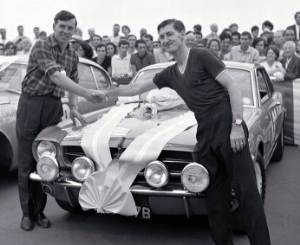
Peter Procter and Andrew Cowan with the winning #83 TDF
car DPK7B.
Picture courtesy Ford Media
Well,
at that time we did not have specific tasks like today. All were working on
different parts of the cars like body work, engine, paint and other stuff. We
were about 10 people with Brian Lewis, Roy Buckfoy, Lionel Brown, Alan Wingard,
Dennis McNif and a few others. Howard Milestone was the team manager of us.
Brian Lewis worked a lot on the Mustangs. I was working on both Falcons and
Mustangs. Dennis had a spray shop, that was where we painted the cars, it was
not only him, I sprayed cars as well. We were all doing things like welding,
mechanical work, spraying etc. There was no specific task assigned.
Plus
of course there was Alan himself, whom we called “wingnut” due to his
outstanding ear form. We all had nicknames. Alan was a very nice chief or better
buddy, we had a lot of fun all together. We went to the pub together and we had
parties, we were a real good team.
The
main drivers were Mike Salmon, John Whitmore, Roy Pierpoint, Sir Gawaine Baillie
and Bosse Ljungfeldt. John and Roy were good pals of Alan. Frank Gardner was
there some time, he was a nice guy too, but compared to the others, he was more
up to being his own boss.
Bosse was the best driver I’ve ever seen. He was
able to steer a car in the air. When I asked him once, how he can drive so fast,
he said: “Well, the street offers you only 3 choices, straight, right or left.
Once you don’t see the road going anywhere behind a jump, it is typically
unlikely it will be straight on, well if it is, you might be confused, but not
in trouble, typically the street goes to the left or right, that makes up a
limited choice. I usually set the car in the right angled position where the
road goes, that’s it. It is
about foreseeing a road course, otherwise
you loose time.”
Roy
was a really good guy and I worked a long time for him. Roy had a shop with his
brother John for heavy machines and stuff like that. His place was a real mess
and you could hide a lot there.
I
lived about 200m from Alans workshop in Byfleet and worked initially at Duncan
Hamiltons, who worked for Jaguar at that time. Byfleet was a really tiny place
where all those things happened back then, there were the (John) Cooper shop,
the McLaren shop, the Brabham Motor Corporation and close nearby the Brooklands
racetrack.
Wakefields body shop was nearby and a lot of others, so if you needed
something, you just went over and rent it, take it or exchange it. It was quite
different than today, even at the racetrack you could go into the next box and
ask for a jack and they asked you for brake fluid or whatever and we helped each
other, no questions asked. It was a big team and at the same time still
excellent competition amongst each other.
Q: What about your first meeting with Alan Mann.
I was a young boy, but I was deep into racing all time. Living in Byfleet meant you had a relation to racing, that’s the same like living near the Nuerburgring or other racetracks around the world. Once you come from the school, you had to be at the racetrack or around in the garages. I was so much into cars and especially Ford, I was the second guy in the UK who received the HOT ROD magazine and all the Ford information. I still have the Hot Rods laying around in England.
I got specification sheets, press stuff everything from Ford and I knew even more like the people that were actually working in that environment. I used to be around in the Brabham shop, where I was “The boy” around and could tell apart any carburetor.
One day Alan was around and he mentioned something about the Ford Falcons that were supposed to be shipped to him and because I knew already, how and when, I said: Hey, you must be Alan Mann and he asked: How’d you know?, Well I said, because you are the guy that receives the Falcons and I’ve got information on those. I told him a few things about the cars and that is how he got aware of me and my knowledge about Ford cars. I changed to Alan Manns team later.
As a boy I used to say Mister Brabham, until he ceased me to do so and call him Jack. Initially I called Alan Mister Mann. But that sounded so funny and the others were laughing, so that did not last that long. I liked him very much, he was a boy as well within the team. It was real fun working in that team.
We had all the money to play around with Ford. They did not care. I even remember Henry Ford stepping in into Alans office in 1966 before Le Mans and he said: “I don’t care of how much it will cost to win. You only have to win.” Frank Gardner later told me it cost Ford 22 million dollar to win Le Mans. Not sure, if it is right, but it was probably.
Q: Can you tell us something about Alans shop and how he came to racing Fords.
Alan
was a salesman first. He got into this car business by chance, I guess, although
he was a really quick driver. He had
done something with Henri Taylor’s Cortina GT and that impressed John Holman.
He was a bit unsteady in his hobbies. Some time he did fishing with me later,
then he did something else. That was Alan. Always looking for the next
opportunities. After the rallye stuff at some time he got interested in
helicopters, when they were quite uncommon in the UK. I think he never raced a
car since then.
Editors note: Since 2004 Alan is back to the racecourses and renewed his
drivers licence.
Although he was a very quick driver and I remember one time, he
went with the Mustang after 3 rounds faster than his famous drivers, he never
was that much into driving himself. He was more a businessman, but as
I said, a real teammate. We
were always joking and good friends. He used to pop in sometime and said, hmm,
what are you doing there? And we just said, ummh, well, you know, doing
something and the other well, doing something on a car as well.
So it was not really a boss-employee atmosphere. On the other hand, when
he called us for a race preparation, we left home and did not return for 48
hours or even ore to finish the car in time.
The time there was a big part of my
life and I enjoyed it very much. The drivers took us for a ride once and then on
the M3 highway, we tested the cars on the road, yes, we were going with the
Fairlanes, Falcons and Mustangs out there on the M3 and tested them.
I once went went with Frank Gardner, he was a joker indeed. After some
time he told me, hey, I lost the brakes and I saw him pumping the pedal with no
effect.
I said, well let’s call the shop, but he said, no way, no problem, we
go back and he still rode like hell, going sideways to reduce speed before the
corners, that was Frank. I was really frightened. But with Bosse Ljungfeldt I
was once really scared. He was the fastest driver I’ve ever met.
Alans
shop was about 100m by 25m large. One end was completely filled with tires and
wheels, later they put another floor in it for offices and other material. There
was enough space. The Ford picture you showed me that indicates Alan Manns shop
(also shown in Alex Gabbard book “Fast Mustangs” is indeed not Alan Manns
shop, it is one of the hangars of Lincoln Cars at the Great West Road in West
London. This company imported all the american cars and was a really big
enterprise. It is no more there, but it was a real big area. It was opposite of
Firestone works.
We also got some of the world rallye Comets with their 289s prepared by Bill Stroppe. Paddy McNally from Autosport Magazine came over to do some shots.
Q: Do you remember, how many Mustangs Alan Mann received?
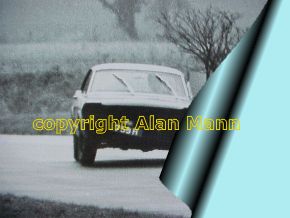
More Pics available by the authour
I
remember the 4 red TDF cars and the red first car. It was not a real prototype, but
it could have been a pre-serial production Mustang. I don’t know the exact
date when it arrived... it was pretty early in 1964 and it was still cold, when
we went to the racecourse with it for suspension testing, but I am pretty sure,
it came via Lincoln cars. Most of our cars came via Lincoln Cars. Lincoln
Cars was the importer at that time for Ford and also brought the Falcons and
others that we had before into the country and over to Europe. They had a lot
contacts with John Holman in the US. Roy
Buckfoy and Lionel Brown worked there initially at Lincoln cars.
There were the early 2 white Mustangs in the shop as well, that were used for the Liege-Sofie Rallye. One was written off in that race. As you heard from Alan already that was the one that went down the hill. The other one was damaged, but was later rebuild. I remember those cars had the tank filler on the rear upper fender. That is how you can identify them.

One of the two earliest Rallye Mustangs - The
1964 Liege-Rallye car DPJ8B licenced Picture Ford
(Pic
available)
The second Liege-ralle car had licence plate with DPG3B
Q:
O.k, now for the 1964 Tour de France cars. We know that there were 4 cars
delivered to Alan Mann prior to the Tour de France event. He himself said that
after his initial driving it around during the first days of the TDF the 4th was used as a spare parts car. So we have
this listing as of now
#83
Procter/Cowan
DPK7B
Alan MannRacing
Winning Car
#85
Harper/Pollard
DPK6B
Alan MannRacing
Second place car
#82
Ljungfeldt/Sager
DPK5B
Alan MannRacing
DNF
#84
Greder/Rive
Ford of France
DNF
#00 Spare car DPK4B Alan Mann racing Not entered, used for parts, then completed and sold to Switzerland
I can
tell you something about the licence plates. Alan always had 3 letters up front
and the last letter indicates the year – in this case B for 1964, A was 1963,
C 1965 and so on. Those licence plates stay with the car for its lifetime
typically.
Regarding
your saying that one car went to the Comstock racing team in Canada, I don’t
remember, it can be, if it was tested there by a magazine, as you say, but I
really don’t remember. I would doubt that Ford gave it away, but entering the
canadian market might be indeed a reason.
Editors Note: At a second visit, John recalled finally that the car was immediately
called back by Ford and sent indeed to Comstock Racing after the TDF.
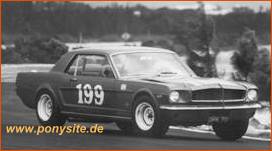
The TDF winner car DPK7B shown with driver Skic Scott at
the Nov. 1964 Nassau Speed week
It later raced also at the 1965 Daytona track.
Q: What do you know about the DPK4B spare part
car?
Alan used to drive it during the TDF for a while, then later he used it
for driving home. I think for about 3 weeks. Not sure what happened then with
it. I think it went back to Lincoln cars.
Editors note: The so-called “spare”
Alan Mann Mustang licenced with DPK4B turned up with the Scuderia Felippinetti
and swiss driver Pius Zünd later. We don’t know yet the whereabouts of this
car.
By the way, we know that the Greder/Rive Mustang (the 4th. Tour de France car) was raced often after the TDF.
Jacky Ickx and co-driver Stapelaire raced another two TDF-lookalike car with a belgium licence plate. Found these pics on the web.
Sorry, I don’t know anything about this other car. We had later more relation with Ford France, when we were in the movie business, but not for the TDF:
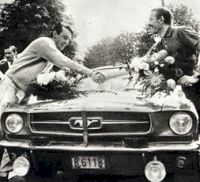
Winner Henri Greder and co-driver Rive at the Marathon de la Route (Nürburgring 82 hours race) 1965.
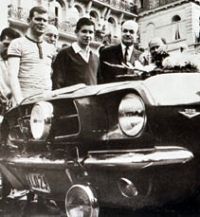
Second placed Jacky Ickx& Stapelaire at the same Marathon de la Route 1965
Q:John,
can you tell us something about the main 3 TDF cars and what happened to
them:
(Pic
will be added later)
The
3 Mustangs of Alan Mann at the start in Reims 1964 Picture Ford

The
3 Alan Mann leading the Ford of France Mustang at the TDF 1964 Picture Ford
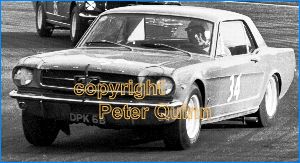
Ex-TDF cars DPK5B behind DPK6B at Druids end, Brands Hatch 1965,
Mike Salmon in DPK5B and Roy Pierpoint in DPK6B
Picture courtesy Peter Quinn
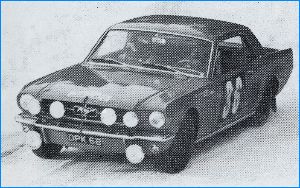
Picture courtesy Graham Robson/courtesy of Jan H./FIN
Bo Ljungfeldt in the second TDF car – DPK6B of Harper – here entered in the Monte Carlo 1965. Starting point was Stockholm. Somebody said: Bosse is the only racer who can drive down a hill with ice and snow with the speed being above 100miles.
(Pic
will be added later)
Bo
Ljungfeldt with the Alan Mann prepared #62 car (1of 3 entered) in Karlskoga/Sweden
August 1965.
(Pic
will be added later)
The
Race is on at Karlskoga 1965. Picture courtesy Motorsportklubben Karlskoga.
(KMK-Veteranera)
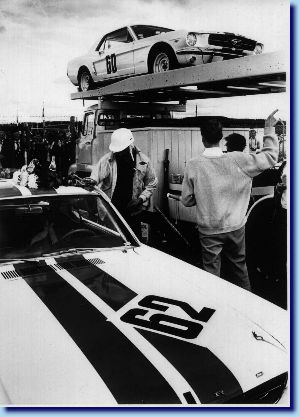
Picture courtesy Bjornar
Djonne/N
Both
ex-TDF-cars at the Karlskoga August 1965 event – 3 white Mustangs were
entered plus 2 Cortinas from Alan Mann. Roys car #62 down there with him
standing next to his car, Brian Lewis on the right pointing upwards. Sir
Gawaine Baillies car still up on the transporter. The third car was most
probably driven by Tarme Olsson and/or Bo Ljungfeldt.
John Grant thinks this is the second surviving Liege car shown
here with the filler on the back rear fenders and the rear fender fake
intake emblems.
There
are a couple of things that I can tell you.
We did not do a lot on the cars in fact back then. We got High
Performance engines, but some engine modifications were done by Vic Huges on the
cars like the highriser intakes, 57 Holley double-pumpers carburetors etc… The
fenders were cut about 2 inch, then flared. Some body work on the Mustangs was
done by Weslake in our neighbourhood, while Dennis McNif worked on the flares as
well and painted them later. One
time in Germany sb. Protested our cars because of that, but we said that those
were High-Performance models and the others were just plain 260ies.
The
double fuel tanks were also done by Weslake, if I remember right. We put on the
Panhard rods, lowered the front upper linkage point ¾”, later 11/16” to get
the cars down in the front. The first cars that came over really looked like
drag cars, they were all set up in the air in the front and they had different
rear springs. We changed the rear springs to an equal set-up. We put Koni shocks
on the cars and 9” rear ends. We left the bigger drum brakes on in the rear,
up front we later used Gerling disc brakes (not initially) and we installed
Raystall seats. We did not go far to get the pieces, we had everything in our
neighbourhood. Roys car had a T10 gearbox, while others had Toploaders. Roys car
also had a Detroit locker diff.
I
remember that Roys car had only a rev counter in it, another Mustang and only
one of them had a Rally-Pac. The
Falcons had a Watts linkage, not the Panhard type. John Crossroads invented them
(to be rechecked).
We
testdrove all our cars out on the M3, the Falcons, Cobra Daytona Coupes, the
Mustangs.
The
Group 2 changed at the end of 1965 for the British Saloon cars championship,
that is why most of them could not be raced in their original condition and were
turned to club racers and got certainly bad and worse over the time. You’ll
probably not find any remainders of the TDF cars today. I would be very much
surprised to see one of them.
As
said, I have no idea about the the first and winners car. But it might indeed went
back to the USA upon Ford’s order.
Editor: John remembered it in the second interview however. Yes, we have reports that it was returned to Ford USA who shipped it
to Comstock for the 1965 Shell Rally. The Comstock own car (as tested in
May by Car and Driver magazine) took first overall driven by Paul Mclennan, and
Eppie Weitzes placed in the top 10 in a Shelby as well.
Roy
Pierpoint drove the Harper car in the other races in 1964. This
second car was sold to Roy Pierpoint in December 1964 and raced by him in 1965,
where he won the BSCC. Yes, I am absolutely sure, we turned an Ex-TDF Mustang into a race car for Roy
Pierpoint at the end of 1964 and I worked on it. Still Bosse drove it as
well in some races. We blew a few engines and had to replace them. Indeed Ford
changed the connecting rods design upon our advice, because we blew so many
Hi-Po engines. They made an additional rib on the lower part close to the
bearing.
BTW
– Roy only won the BTCC championship, because Alan Mann called Sir Gawaine
Baillie in the pits at the final race. Sir Gawaine was leading with Jack Brabham
following. Roy have had an accident and smashed his car at Furnace corner and
lost 10 places and Roy would have lost the championship, but Sir Gawaine
followed the pits order – although he was not happy about it – but he got a
nice wrist watch from Alan as a reward.
Brabhams
car was protested by Alan Mann and when they removed the cylinder head of his
car, they found triple valve springs, one of it being used as a dampener. That
was not allowed back then, so the protest went through and Roy won the
championship.
With
Group 5 coming out the next year, Roy fitted a Paxton supercharger, which I got
him from the States. He did a couple of races with this before starting on the
Falcon, which was more lightweight and dominant.
In
1965 the DPK6B car was also used at the 1965 Monte Carlo race with Bo Ljungfeldt
driving and at the Nürburgring with Jacky Ickx and Jochen Neerpasch
He
sold the car to a business man called Paul Rackham from Norfolk who painted it a
bright Yellow with black stripes and Roy drove it with Rackham in a round of the
European touring car championship at Snetterton in Norfolk. But it blew its
engine in the first hour. I know Rackham drove the car later in a few club races
after the engine was rebuilt, but I don’t know what happened then. Roy went on
with his Falcon.
Editors
note: Jeffrey Harris got in touch with Paul Rackham and obtained a few pics of
the ex-TDF car while being raced by Paul and his driver Teddy Savory.
Acc.
to Paul he sold the car after this season to a guy in Liverpool, who raced the
car as well in club races and later killed himself in the car. This DPK6B
Mustang is most probably written off and gone. We have a final pic of the car of
1968.
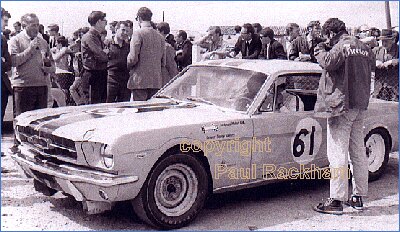
Pictures courtesy of Paul Rackham
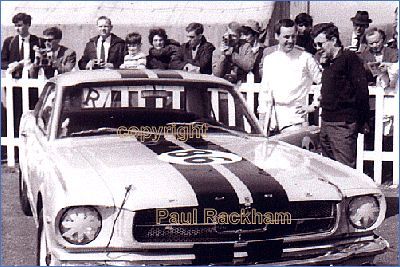
John
remembers that Dodge transporter: “It was really dangerous. I remember when we
came back from Karlskoga. Brian Lewis drove the transporter with his wife next
to him and 2 other team members next in the front cabin. We were sitting in Roys
Mustang back on the ramp and Sir Gawaine Baillie sitting on top in his Mustang.
When the transporter went into a curve, we were really bending over in our
loaded cars. That was real scary, but those were the days.
In the early days we had no transporter, we drove with the race cars on the road home or to the racetrack. Only Sir Gawaine Baillies car was pulled by a Galaxie station wagon. His car was always in showroom condition.
Q:
That says something about DPK6B, the Peter Harper car, what about the third
TDF car? I have pics of Sir Gawaine Baillie in a – what looks like a TDF
car.
Could it be the original Ljungfeldt car with no. 82?
No, Sir Gawaine Baillie had a brand new car, which was a darker red than Roys orange car, indeed cherry red. Sir Gawaine had his own mechanic, Tedd Touphen. I remember when Sir Gawaine Baillies car came in, it had to be prepared for its first race in the 1965 season, I think Brands Hatch, within 48 hours. It was just moved over on its side, the welding and mods on the suspension were done and then it was race-ready.

Picture courtesy "classicford"/G. Robson
But
Jack Brabham - I
think - got another Mustang for driving. He raced for Alan Brown, who at that
time owned and run Conought Cars. I do remember a later blue /grey Mustang, that
was the ex-Brabham car. This car was written off at Silverstone 1966, after an
elder driver ( I don’t remember his name) crashed the car in an accident. So
that would be probably gone as well.
Editors note: a different Mustang hat went to Jack Brabham. Note the modified fender flares. John Grant believes this was written off after an accident in 1966, as he remembers. We contacted Jack Brabham and he told us that he did not own the Mustang, he was just driving it. Jack also points out that he did not crash the car, the only car he crashed was a Galaxy of Alan Brown in 1964. Other than that he does not remember a lot about the Mustang. After 1965 he never drove a saloon car except for a celebrity race.
Q: John, we have this picture of Jack Brabham saying
1965
Gold cup meeting, a BTCC race I assume?

The picture is taken from the
book "Ford's competition cars" by Barry Gill and Michael Frostick. Picture courtesy
Frank …?
Bo Ljungfeldt with the ex-TDF car at Larvik 1965 in Norway (Picture courtesy Bjornar Djonne) John is not sure about this pic due to the air scoops below the car. They were not allowed in group 2, but later in Group 5. Still it looks like a Alan Mann car, but the licence plate is a bit of a mystery.

Roy Pierpoints Ex-TDF car DPK6B with Jochen Neerpasch at the wheel in front and Sir Gawaine Baillies painted ex-cherry red 65 model Mustang behind at the Nürburgring 1965.
This could be only a Mustang used in Group 5,
not in group 2 due to the rollcage and the air scoops. I doubt that this one is
an original TDF car, but it could be and the face does not look like Jacks. I
think it is another car. At least it is a race in 1966, not 1965. There is Brian
Robinson behind this Mustang in his car..It could be the ex-Brabham car, but I
doubt it.
Pic
will be added later
Alan
Mann on right with Bo Ljungfeldt on left. Middle Ford race team chief ….
Picture B.Cahier
Pic
will be added later
Alan
Mann (on right) with Bernard Cahier (photo). Peter Procter and Andrew Cowan
listening.
Q:
We’ve other pictures of Mustangs
with blue stripes on white being driven. What do you know about these.

Silverstone 1965 - Pierpoint
and Sir Gawaine Baillie in their Mustangs at the start – Picture courtesy
Graham Robson

Pierpoint
leads the heard in his ex-TDF car DPK6B at Crystal Palace 1965. Picture courtesy
Graham Robson

Sir
Gawaine Baillie at Silverstone 1965 – not an ex-TDF car, but with the same
alterations on the flares.
Yes,
later Roys and Sir Gawaines cars were both painted white with two 4 inch
Guardmans blue stripes over them.
However
the Baillie Car was not a TDF car.
It was always in show room condition and I am sure it was converted back to a
road car later, because it was in such decent status..
Mike
Salmon had DPK5B painted dark blue Mustang later and raced for F. English in Bournemouth/Dorset,
a garage owner. I think the Salmon car was used later as a club racer.
Editors note: Acc. to our interview with Mike Salmon, it went to Rob Slotemaker acc. to Mike Salmon, whom we contacted
in 2004.
More about this car is available here on this site and
www.racinghistory.nl
Q: Did you ever see those cars again and how can you verify them, if you see them?
In
the time since those days I have been to many Historic races and seen many so
called ex-Alan Mann Mustangs and Falcons with some very well known names
claiming to own these cars, but sadly most are fakes.
I know one sure thing to tell them apart and that is to do with a certain
piece of welding that I did on nearly all the Race Falcons or Jim Rose did to
them and I certainly did on Roys Mustang. In those days, you did not MIG welding,
it was all abut Nickel-bronze welding and any welding is a sort of a signature.
We had to weld some items up, as the car tend to crack in those areas. They
really got clapped out with these rallye roads.
I’d
know immediately if a real car turns up, but I really doubt it will.
Q: BTW, do you remember any other work being done on Mustangs in your shop
Yes,
we worked on 2 private cars and I remember one of them was a Shelby. It came
with a Paxton Supercharger already installed and Roy drove it at some club races
at Brands Hatch. Phil Remington from Ford Advanced Vehicles was his contact man.
I
had read in a Hot Rod magazine about this Supercharger and after talking to Alan
Mann, he ordered one set for the other Mustang. We put that one on Roys race
Mustang for the 65 season.
But this Shelby came via Southampton directly to us, not via Lincoln Cars. It
was around our shop for some weeks, then it went off, not sure where. It was the
only Shelby that was ever in our shop.
Editors
note: Alan Mann said in an earlier interview with me that he sold a bunch of
Shelbys standing at FAV after the London Motor Show, FAV not being able to sell
them themselves.. This leaves some speculation about more Shelbys being through
his hands, but apparently not via his shop.
There
is at least one Shelby with a Paxton still in Belgium, that went via Claude
Dubois.
John continues: The other private Mustang we had in the shop was owned by the conductor of the welsh symphony orchestra. His name is Wynn Davies. It was more a road car, but we modified it a bit.
Q:
Can you memorize something about the 65 Boxing Day event (1st week of
1965), where Alan himself entered and raced one of his
Mustangs?
(Pic available)
Yes, Alan drove a plain white Mustang that was crashed
before in the Liege rallye. It is the second Liege car, the first one was
totally crashed there and written off.
This car was really hard damaged, that is why it looked so heavily
modified at the Brands Hatch Boxing day race. We fixed it up shortly before the
race. It ran with a Cobra engine and was so fast that he easily won the race. I
don’t know what happened to it later.
The Brands Hatch event was not really on Boxing day early 1965, this one was
cancelled, the event Alan Mann drove it, was indeed two weeks later, but it was
probably reported as the Boxing Day race. There was another Mustang Fastback in
that race, a green one, driven by Ken Baker.
Q: Did you hear that Alan Mann bought back one of his red/gold Lotus Cortina?
Not
exactly, I remember the 1962 Cortinas, Andrew Taylor and Henry Tailor got these.
Seeing the article in Classic and Sports cars August issue2004, it is one of the
Lotus car, not the original Alan Mann car. Partially we were driving for Lotus,
but partially we were also competing. As you can see from the licence plate this
is not an Alan Man car.
I heard that John Holman has a Falcon now in his workshop that will probably be
send over to the UK again.
Roy
Pierpoints Falcon went to Dennis Walsh and was a complete write-off. The Baillie
Falcon was raced by Brian Muir as well. Brian was a Daimler dealer. It got a
club racer later. I remember it being driven at Silverstone.
Then
there was Jack Price as well, who used one Falcon as a club racer as well.
I still have the Alan Mann 1965 Christmas Card, that shows Paddy McNallys pic
with the Daytona Cobra, a Mustang and a Falcon. Paddy was the photographer from
the Autosport magazine who always went first into our shop or Lincolns shops,
once there was something about new cars arriving.
Q: Regarding the movie business Alan Mann was in later, what can you add to the statements Alan Mann made?
Yes,
Andrew Cowan drove the Mustang convertible with a wig on in Goldfinger. It was a
fairly standard convertible. I don’t know where it came from and where it went.
I assume it was written off. They had enough money and those cars typically were
written off. Brian Lewis had to
drive back the Aston Martin from Switzerland. Somewhere at Red Hill he
apparently fell asleep and drove the valuable DB5 into a garbage car. It was
seriously damaged.
You
know we have been into various movie projects like the Chitty-Chitty-Bang-Bang
and a few others.
I remember very well Steve McQueen - you know – was planning his movie “Day of Champion” for a long time, but as he – let’say got a nervous breakdown – he never made it. MGM picked it up with James Garner. We prepared the Formula 3 cars. As you know there were quite a variety of fakes. I you watch the movie closely, in some scene you can see the shaking body parts, that we put on the cars. They were real mock-ups. We also prepared a Lola T70 Spider as a camera car and a GT40 as well as a camera car. Those were initially thought for the Steve McQueen movie, but MGM bought every bit to do it with Garner in GRAND PRIX. I don’t know anything about the Hertz Shelby used in that movie, but I remember there were 3 Hertz Shelbys available in the UK back then. You could rent them when you were over 25 years old.
Q: Which other Mustangs do you remember?
I
remember that the Quarterhorse called Mustang came over to the UK with a 390 in
it. It was prepared by Bill Stroppe and was given to Jack Pierce (or Jack
Price).
Martin Birranes TransAm racer sponsored by Kona coffee, I do remember as well. Martin owns now Mondello Race Park and more. He is a very rich man. In the glory days he drove the 7 litre Galaxie as well. The doors were welded up and they could not be stopped. Those cars really made a big impact over here in the UK.
Q: Any other anecdotes?
Let
me think, well Alan at one time had a Ferrari 255GT. Imagine – that was really
impossible to show to Ford people. He stored it behind my house.
Another
story is that we had our workshop filled up with a lot of memorabilia, but one
day they were all gone. Alan said, the Ford officials did not like them, so they
had to be removed.
Q: What about the service van Econoline with the big engine?
Yes,
we had that green monster. It was driven by a lot of our people. Everybody liked
it. It was tested by Motoring News at Santa Pod once and they found out, it was
even faster than the latest Aston Martin, they had. We had only once with the
big engine, the others had a 170cui 6 cylinder. Those 4 cars where in a creamy
colour, while the 390 Van was a green one. Bob Hadlington drove too fast in a
turnaround and turned it over. We had to repair the damage and later it was
given back to Lincoln cars. Goodyear had another one, but just with a 200cui
engine.
Another
anecdote might be, when we went tire testing to Goodwood. Alan always was keen
on looking serious, so he often wore a tie, even during those tests. I remember
him coming out of corner sideways and immediately correcting his tie on the
straight. Regarding his helmet, he just put his old semi-helmet on and left the
strap open. A real gentlemen driver.
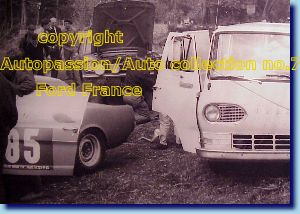
During
the TDF – one of the 4 Econoline
6 cyl. Vans servicing Mustangs. Foto Photo Collection McdF
Q:Thanks a lot, John. Hope to see you again at the
racetracks.
No
problem, if you would like any more info on this subject I’ll be happy to try
and help, this was to me such a great time and for a young man the best start
that I could have had working for Alan and with such a great bunch of very good
mechanics, I will always remember those days in Byfleet,
my home village.
I'm actually looking for a vintage race team to help. I've been a lot into drag
racing the past decades and I have a shop with a partner here in the Netherlands.
More:
Alan Mann Interview
Lee Holman Interview
The Mustangs:
DPK4B Spare car
Driven by Alan during TDF,
then partially disassembled, reassembled and sold to Pius Zuend/Ecurie
Felipinetti
DPK5B
DPK6B
DPK7B
Additional
pics available from B.Cahier